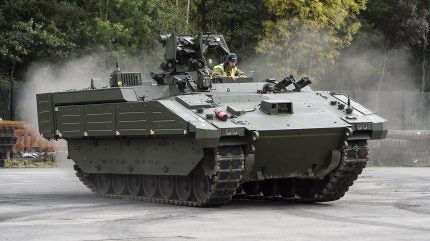
The Ajax armoured vehicle programme, plagued by issues ranging from vibration concerns to delivery delays, faces scrutiny as it inches closer to achieving initial operating capability (IOC).
Initiated in 2010, the programme aimed to equip the British Army with a fleet of fully digitised platforms to replace the ageing Combat Vehicle Reconnaissance Tracked (CVR(T)) family.
Led by General Dynamics European Land Systems Group, the programme promised capabilities, including enhanced reconnaissance, surveillance, and survivability.
However, the road to realisation has been far from smooth. Initial delays pushed back the timeline for equipping the first British Army squadron, with testing issues surfacing.
Testing delays and technical issues
The original plan foresaw the first British Army squadron being equipped by mid-2019, but there were a series of testing issues, including an inability to reverse over any terrain higher than 20cm, as per GlobalData’s intelligence on the UK defence market.
Noise and vibration problems emerged as significant concerns, impacting crew health, stability of armaments, and electronics functionality.
These issues led to a suspension of trials in November 2020, underscoring the magnitude of the technical challenges faced by the programme.
Despite reassurances from defence officials, including then-defence secretary Ben Wallace in February 2023, about the programme being “back on track,” concrete milestones and solutions to underlying issues remain elusive.
The latest reports indicate that only 26 out of the intended 589 Ajax vehicles have been delivered, and none have been deemed deployable due to unresolved technical issues.
Programme suspensions and milestone delays
According to GlobalData’s “The Global Military Land Vehicles Market 2023-2033” report, the UK is investing in one of the largest IFV programmes in the European region, acquiring 245 Ajax IFVs for $3.3bn (£2.64bn).
Harshavardhan Dabbiru, an aerospace, defence, and security analyst at GlobalData, highlights that since the Russia-Ukraine conflict, there has been “renewed attention” on the more fundamental warfighting capabilities of the British Armed Forces.
“With the Army being the least modernised armed force, the focus is on several key procurement programmes. The focus on Army modernisation will continue to drive the country’s policymakers to take measures to overcome the delays and challenges associated with the programme in the next decade,” Dabbiru said.
The implications of these delays extend beyond logistical and operational concerns. The Ajax programme, with a firm-priced contract of £5.5bn, represents a significant investment of taxpayer money.
The Public Accounts Committee has raised alarms about the potential impact on national security and additional taxpayer expenses if the issues are not rectified promptly. As alternatives, such as upgrading the Warrior infantry fighting vehicles, are considered, the fate of the Ajax programme has previously hung in the balance.
Glimmers of hope
Despite the challenges, there are glimmers of progress. Lockheed Martin reports over 50% completion in turret production, signalling some advancement in production capabilities. Recent trials in Swedish Lapland showcased the Ajax platform’s resilience in sub-Arctic conditions, offering hope for its operational viability.
Looking ahead, the Ministry of Defence remains committed to the programme, resuming payments to General Dynamics to expedite delivery. The goal of achieving initial operating capability (IOC) by mid-2025 and full operational capability (FOC) by the late 2020s persists, albeit with uncertainties surrounding timelines and technical feasibility.
Harshavardhan Dabbiru provided his opinion on how realistic the IOC and FOC goals are: “Despite the delays, overbudget, and technical issues that plagued the programme over the years, the British Ministry of Defence (MoD) is taking measures to accelerate the Ajax programme timelines and avert further delays.”
In February 2024, the MoD outlined efforts to expedite the vehicle delivery schedule, which include optimising the build lines, recruiting additional resources, and focusing on increasing collaborative practices for the programme.
These might help the programme achieve its initial operating capability by 2025, and if further delays can be averted, the programme might achieve its full operational capability by 2028-2029.
The crossroads of the Ajax programme
The Ajax armoured vehicle programme stands at a crossroads, with its future hanging in the balance. While the promise of advanced capabilities and modernisation remains tantalising, the reality of delays, setbacks, and technical hurdles paints a sobering picture.





